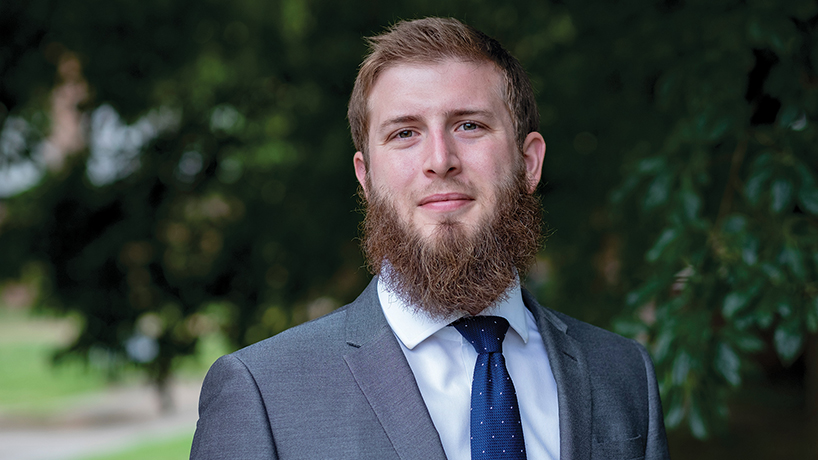
Data science and statistics doctoral student Ken Smith creates software that graphs connections among the DNA of individuals with Alzheimer’s as part of Assistant Professor Sharlee Climer’s lab. (Photo by August Jennewein).
Ken Smith didn’t get a yes when he first approached Assistant Professor Sharlee Climer about joining her lab. It might have struck her as an odd fit to bring on the PhD student in data science and statistics because Climer is a computer scientist.
But Smith was so intrigued by her research identifying patterns in genetic data that he persisted.
“I kept bugging her and bugging her until she said yes,” Smith says. “I really liked that she was working on a problem I could see – I’ve known people with Alzheimer’s or dementia.”
Climer’s lab turned out to be a great match. Since joining in 2018, Smith has completed software for identifying clusters of related data in large sets, which he presented at the Genetic and Evolutionary Computation Conference in 2019, and has embarked on a project developing an Alzheimer’s diagnostic technique in collaboration with Washington University School of Medicine genomicist Carlos Cruchaga.
The problem-solving elements of his University of Missouri–St. Louis research play into Smith’s background. After earning his bachelor’s in physics and a master’s in electric engineering, he’d started at Boeing. A few years in, he’d wanted to brush up and enrolled at UMSL part-time.
A little over a year later, he decided to go for his doctorate, started working with Climer and then switched to full-time.
“I’ve always liked problem solving,” Smith says. “This field has a lot of applications, so I can work in aerospace, in medical research, business. A lot of it is very similar math. It’s how you apply it.”
Starting with Climer meant going back to the basics to learn about programming and artificial intelligence. From there, he jumped to creating software that graphs connections among the DNA of individuals with Alzheimer’s.
Similar to how a social network such as Facebook draws connections among friends, Smith’s program clusters mutations.
“You try to figure out which mutations occur together,” he says. “You want to figure out which of those mutations occur often for Alzheimer’s patients but occur for non-patients rarely. If you find that kind of pattern, then there’s a good chance those mutations either cause or are associated with Alzheimer’s.”
Working with DNA produces a vast amount of data – hundreds of thousands or even millions of samples. That means the solutions from Smith’s program are approximations, so he chose spinal fluid proteins to examine next.
He’s taking a similar approach by looking for proteins that are present at higher levels in Alzheimer’s patients than non-patients. Smith hopes that by identifying these proteins, researchers can look at their functions in the body and use them as a screening mechanism for high-risk individuals.
He’s spent the last year creating and speeding up the program under Climer’s guidance and is now ready to start analyzing patient data.
“The problem with Alzheimer’s is that once you can identify that someone has it, it’s typically too late to fix it,” Smith says. “If we can detect it earlier, we can prevent it from getting worse, and I think that’s reachable.”
This story was originally published in the fall 2020 issue of UMSL Magazine. If you have a story idea for UMSL Magazine, email magazine@umsl.edu.














